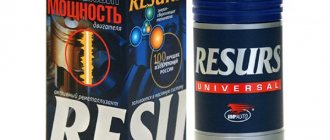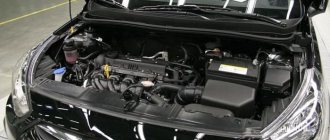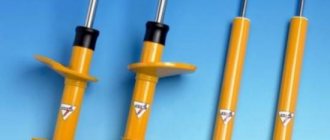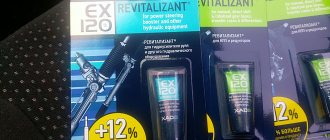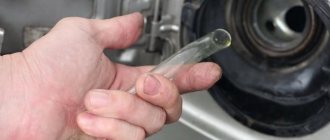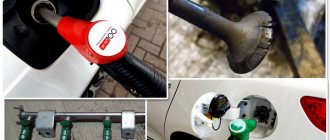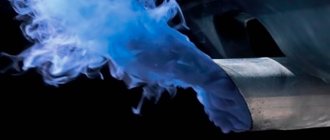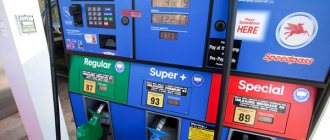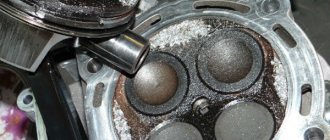11.02.2020
| (Votes: 1, Rating: 5) |
Issues discussed in the material:
- What is a fuel additive
- Is it worth using fuel additives for gasoline: two opinions
- What additives are added to gasoline: classification
- Top 7 best additives for gasoline
- Dangerous fuel additives: do not add this
- Useful tips
- What additives do Russian car enthusiasts add (opinions)
The question of what additives other car enthusiasts add to gasoline has recently begun to appear more and more often on thematic forums. Suddenly it turned out that many car owners did not know at all about special additives that can slightly change the chemical composition and physical properties of gasoline.
In this material we will analyze in detail what an additive is, who adds them and why. We'll tell you what types of additives there are, how to choose the right mixture specifically for your car, so as not to spoil anything. We will also list the highest quality and best additives for gasoline.
What is a fuel additive
Motor gasoline is a flammable mixture of hydrocarbons (octane, hexane, heptane, etc.) released during the distillation of oil. It is not used in its pure form and is often diluted with special additives - other types of fuel and components - to change its properties. The introduction of fuel additives into gasoline is regulated by special standards (for example, GOST R 51105-97).
Additives added to gasoline account for only 2% of its volume. But despite this, they play an important role in the composition of the fuel, namely:
- They increase its resistance to detonation, that is, explosive combustion, which is indicated by knocking in a running engine, increased exhaust smoke and a sharp drop in power.
- Reduces engine overheating.
- They improve the volatility of gasoline and, accordingly, the formation of a combustible mixture when air enters.
- Reduces deposits in the engine and other mechanisms in contact with fuel.
- Reduces carbon deposits in the internal combustion chamber and exhaust system.
- Reduces the content of sulfur and benzene in exhaust gases.
Today, there are about two dozen chemical compositions, from which manufacturers obtain many additives by mixing the components in different ratios. According to their purpose, they are all divided into several separate groups.
In addition to special mixtures that are added to gasoline at oil refineries, there are independent fuel additives used by drivers when operating cars. These products are manufactured by third party manufacturers.
Description
A variety of correctors are produced by companies from Russia, the USA and Germany.
The use of additives will increase the octane number by 6 units.
The product may contain various high-octane components: gasoline combustion regulators, nanocatalysts, additives.
The bottle can be plastic or metal.
The effectiveness of the action depends on several indicators: brand of fuel, special additives, manufacturer.
It is not always rational to use an octane corrector. It is applicable when the engine uses turbocharging or an increased compression ratio.
Higher pressure in the chamber leads to an increase in the extracted mechanical energy, but also requires the use of fuel with a high octane number. Only in this case will it be possible to avoid the detonation process.
Also, high-quality fuel allows you to reduce fuel consumption and increase productivity.
Should I use fuel additives for gasoline: pros and cons
It is quite difficult to clearly answer the question of what additives are added to gasoline and whether they are effective. Each group of additives has its own properties. One thing is certain: this is a voluntary matter. Even car manufacturers that manufacture such products limit themselves to recommendations and do not require the mandatory use of additives. For example, Mercedes or BMW brand detergent additives are not prescribed for use in fuel.
- Arguments against the use of additives
In addition, independent testing by Russian consumers has shown that generic additives and catalysts are ultimately useless. The reason is that the catalysts also contain ethers and alcohols, which help achieve the desired octane number at the refinery.In other words, buyers add an additive to gasoline in order to simply change its brand (for example, turn AI-92 into an analogue of AI-95) for an additional fee. Considering the cost of the additive, such fuel is more expensive than a liter of regular fuel with a higher octane number.
The second motive for using additives is to improve the quality of poor fuel purchased at a random gas station. But in this case, instead of supplements, it’s easier to change gas stations and choose a more reliable seller. This is much more profitable than thinking about which additive is best to add to gasoline in this or that case.
Universal fuel products can improve several properties at the same time. Their cost is higher than those additives that are used to solve one problem. But in fact, due to the multicomponent composition and low concentration of each individual element, additives do not have a noticeable effect on the functionality of the fuel system and exhaust gas removal.
The remaining groups of gasoline additives do indeed provide benefits, but their effect is limited. Don’t expect that the dryer will completely remove water from the gas tank and fuel system, but that with the help of detergent components you will remove all the deposits and deposits that have formed over the car’s impressive mileage. There will be an effect, of course, but not a 100% result.
- Arguments in favor of using additives
The range of these products is growing and updated. After all, many car owners regularly add additives to gasoline; they consider them useful for the daily operation of their cars. And by and large you can’t argue with that.The problem with fuels with additives is their versatility. They are designed for mass consumption and are suitable for all vehicles. A small concentration of additives is not able to eliminate the problem of every car. Most often, owners of used cars become adherents of auto chemical products. The reason for this is the stable accumulation of scale and contaminants in the valves, fuel supply system, etc.
If the fuel sold by gas stations meets all GOST standards, the question of what additives are added to gasoline at gas stations will lose its relevance. But these days, when standards are met by 20-30%, drivers have no choice but to take measures to improve the quality of what is poured into the gas tank of their car.
This is why fuel additives were created. They have a lot of functions and tasks, so additives are divided into groups. Depending on the problems with the car, the driver selects the right mixture to temporarily make his life easier and extend the life of the vehicle.
Effect of additives on engine performance
It is worth noting that the validity period of the listed additives is not very long. In addition, they quickly break down. In this regard, the engine may be affected in different ways. And here it is worth focusing on one important point.
When using a significant amount of additives, gasoline acquires the ability to conduct electricity, which its factory-made counterparts completely lack. And thanks to this, there remains a high risk of fire in the power unit. And this, in turn, becomes unsafe for all surrounding road users.
What additives are added to gasoline: classification
Let's consider the properties of fuel additives. Any specialist in this profile will immediately list common gasoline additives, such as: Liqui Moly, Hi-Gear, Lavr, Suprotec, Bardahl, Fill Inn. Their purpose will be immediately mentioned - moisture-removing, washing, octane-boosting. At the same time, the professional will not talk about the marketing advantages of this auto chemical product, but will emphasize their additional qualities.
If we compare the composition of the mixtures that are added to the fuel with the influence of each of the components, we get the following picture:
- Starting additives – increase the volatility of fuel, which is very important in the cold season.
- Friction modifiers – reduce wear of rubbing pairs by forming a film on the surface.
- Running-in additives – improve the grinding of parts after major repairs.
- Corrosion inhibitors – reduce the destruction of oxidized metal.
- Stabilizing additives prevent gasoline from oxidizing during storage.
- Catalyst components - activate the combustion of the liquid and slow down the appearance of soot.
1. Increase octane number
So, what additives are added to gasoline to increase the octane number? It is known that octane boosters are produced from iron oxide, manganese compounds and aromatic amines. Experts do not recommend saving on anti-knock agents or using them in unlimited quantities. An excess of the optimal dose of octane corrector causes very rapid wear of the spark plugs.
In general, these “drugs” are considered emergency, especially if the engine starts knocking after refueling. In fact, such impurities increase the octane number by 0.5, maximum 0.6 units, although the figure on the packaging is unreasonably inflated.
We recommend
“Which engine additive is better: 2022 rating based on reviews from car enthusiasts” More details
2. Removing water
Desiccant additives prevent water crystallization at subzero temperatures. They can even partially remove it from the gas tank. Conventional additives for removing moisture from gasoline bind 10% of their total volume of water. For example, to remove 25 ml of liquid, you need to add 250 ml of the chemical composition. Professionals recommend using these additives constantly; they will not affect the functionality of the mechanisms.
What additives are most often added to gasoline:
- Step Up Fuel System Dryer;
- Liqui Moly Fuel Protect;
- Water Remover Agat Silverline Auto;
- Astrohim;
- Kerry;
- Eltrans;
- Lavr.
3. Flush the system
Detergents contain surfactants (surfactants). They are used to remove varnish and resin deposits, as well as decarbonize the engine. There are mixtures intended for injection units and carburetor engines. Additives do not need to be added if you fill in gasoline with the octane number specified by the manufacturer and with the prefixes “Ecto”, “Plus”, etc.
Ignition timing
One of the most important parameters that significantly influences fuel consumption, power and other characteristics of gasoline engines is the ignition timing angle (IAF), which determines the moment of ignition of the combustible mixture in the cylinders. This parameter has a complex multidimensional dependence on temperature, load and engine speed, quality
Incorrect adjustment of the ignition timing can lead to detonation (explosive combustion of the fuel mixture in the cylinder), accompanied by the appearance of shock waves. This significantly reduces both the power and service life of the engine, up to the destruction of compression rings, lifting of cylinders, burning of valves and pistons, which threatens major repairs. However, the closer the combustion conditions of the fuel mixture in the engine are to detonation, the higher the engine efficiency. Therefore, optimal engine adjustment corresponds to its operation at the limit of detonation.
Standard mechanical formers of the UOZ - vacuum and centrifugal - have unstable time characteristics and require regular checking and fine-tuning on a special stand. Almost no one does such work in car service centers anymore. However, each engine, depending on adjustments and degree of wear, has its own characteristics when detonation occurs. A big contribution is also made by the instability of fuel quality, which leads to the need to adjust the ignition after almost every refueling of the car.
There are a number of devices - octane correctors, which allow you to adjust the OZ manually from inside the car. However, they all have a number of disadvantages, the main one of which is the constant need to listen to the motor and determine the need for adjustment by the sound of its operation. This is not easy to do in the midst of traffic and noise, even for a very experienced driver.
Today, thanks to the use of various sensors, control of the ignition timing of the combustible mixture in engine cylinders is most optimally implemented in microprocessor-controlled injection systems. Engines equipped with such a system are more powerful, more environmentally friendly, consume less fuel and are not critical to the quality of gasoline. In injection cars, the SOP changes depending on the driving mode, but in carburetor cars it does not (more precisely, with less dependence).
Top 7 best additives for gasoline
On the shelves of modern auto stores there is a huge selection of fuel additives from both famous brands and little-known companies. Let's figure out what additives are added to gasoline to clean the fuel system and improve the quality of the fuel. Below we provide an overview of the best products used by vehicle owners. This rating was compiled after processing tests and reviews of ordinary drivers that they left on the Internet.
Of course, the choice of auto chemicals depends on the assortment of stores in each region, the composition of the mixture, quality, price and other factors. Do not forget that it is better to buy fuel additives from reliable sellers who have permission to sell these products. This will protect you from purchasing a fake. So let's get started.
1. Hi Gear Octane Plus Cleaner
It seems that this is the most popular octane corrector for gasoline that our motorists buy. It is made in the USA and is sold in a pump bottle (237 ml capacity).
A special complex, “Friction Winner” (ER), is added to the additive, which prolongs the service of the fuel system thanks to softeners and extreme pressure substances. Its presence will increase the octane number of the fuel by 5-6 units (in fact, according to experts, by 2-3) and will prevent deposits from appearing on the engine valves and in the combustion chamber. This reduces wear on fuel system parts. The octane corrector also reduces engine detonation, eliminates hot ignition, and saves fuel by about 5–7% (confirmed by testing).
2. Liqui Moly Octane Plus
It is better to add this octane corrector to gasoline if you have been filled with bad fuel at a gas station. Bottles with a capacity of 150 ml are designed for 50 liters of fuel.
The manufacturer promises that the additive improves the octane number by 2–5.5 units. taking into account the quality of gasoline. This means that the same portion of the corrector acts differently: with AI-92 the octane number increases more than with AI-95. This catalyst eliminates engine detonation, makes it more powerful and slightly improves dynamic properties. The additive does not contaminate spark plugs and does not pose a danger to the catalytic converter. If you are interested in what additives are added to gasoline to clean injectors, then this product is the best option.
We recommend
“Gasoline additives for cleaning: recommendations and tips for use” More details
3. “TOTEK UMT”
The last three characters of the name stand for “motor fuel booster.” This is a successful project from a Russian manufacturer.
In addition to increasing the octane number, the catalyst has an additional effect:
- improves motor performance (its efficiency) and its torque by about 7 units;
- reduces fuel consumption by 5%;
- protects the contact surface of valves and injectors from clogging and carbon deposits;
- removes a layer of ferrocene from spark plugs;
- eliminates detonation in the engine;
- reduces the emission of hazardous compounds (CH, CO, NOx);
- removes moisture from the fuel system.
Motorists note that thanks to this additive, gasoline is burned faster, which cools the engine and removes moisture.
4. LAVR Octane Plus
A very effective tool that will help you resolve the issue of what additives are added to gasoline to increase the octane number. It is recommended if the engine is operating under too much load. The mixture can be used regularly.
This will improve the condition of the engine, namely:
- increase the octane rating of the fuel by 5-6 units (taking into account the quality of the fuel);
- avoid glow ignition and detonation;
- reduce the appearance of deposits on fuel system elements;
- increase the power of the internal combustion engine, while simultaneously saving gasoline consumption;
- extend the life of your car's engine.
The product is supplied in 310 ml cans. Product code LN2111.
5. Castrol TBE
A universal, highly effective additive that has won recognition from car enthusiasts. It is added to fuel with an octane rating of 91–98 and is used for injection and carburetor engines. In addition, the additive is suitable for internal combustion engines with catalysts and turbines.
Please note that Castrol TBE does not affect the octane number of the fuel! The mixture was created for other purposes: to protect the fuel system from corrosion and freezing; prevent the accumulation of dangerous deposits in fuel injectors and lines; clean the fuel system from persistent deposits.
6. Wynn's Supremium
A multifunctional additive for gasoline, which theoretically should improve its quality (according to the manufacturer’s promises). In fact, as practice shows, this is a common PR move for the company. But we must give the product its due, since it still brings benefits:
- reduces fuel consumption;
- cleans the parts of the fuel system (nozzles, injectors, valves and lines);
- extends the service life of the motor;
- plays the role of a lubricant, keeping engine parts from wear;
- protects internal combustion engine and fuel system elements from the effects of corrosion;
- removes water from fuel;
- reduces the harmfulness of exhaust gas by 30%;
- speeds up cold engine starts.
When deciding which gasoline additive is best for the car owner to add, keep in mind that Wynn's Supremium will improve the performance of your engine. But perhaps not as much as the manufacturer promises. Nevertheless, this product is recommended for use.
7. LAVR Dry Fuel Petrol
This mixture will allow you to quickly dehydrate the fuel. This is an inexpensive and fairly effective product that will help remove moisture from low-quality gasoline. The additive is also suitable for storing a car in the off-season.
How the product works during use:
- actively neutralizes water, constantly circulating in the fuel system;
- has defrosting properties and prevents the formation of ice;
- stabilizes the operation of the internal combustion engine in any mode;
- accelerates the start of a cold engine;
- increases the capabilities and service life of fuel fittings.
The additive of this brand has shown good consumer properties. It is quite suitable for constant use and especially in winter. This additive is good to have in stock when there is suddenly bad gasoline in the gas tank.
The automatic octane corrector “Silych” allows you to:
- increase the efficiency and power of a carburetor engine;
- make it easier to start a carburetor engine (especially in the cold season);
- reduce fuel consumption of a carburetor engine by 3 - 5%;
- increase traction torque at low speeds;
- increase engine service life;
- reduce engine noise;
- compensate for variations in fuel quality by 5 - 7 octane units;
- in an emergency, use low-octane fuel for a short time (contrary to the manufacturer’s recommendations),
- When using gas fuel on a carburetor engine, take into account the characteristics of its combustion to form an optimal dependence of the SOP on the crankshaft speed.
What additives do Russian car enthusiasts add?
- “I recommend Castrol” “Customers often ask which gasoline additive is best to add to a particular car. In our car service, we advise everyone to use additives from Castrol. We also use it ourselves. The mixture is sold in a bottle with an orange glass-shaped cap. I won’t tell you the exact name, but I warn you: this mixture will not clean the engine and fuel system. It will protect against subsequent contamination.”
- “Choose a normal gas station, forget about additives”
“I recently came to a disappointing conclusion, please do not be offended by my words.I am sure that gasoline here and in neighboring countries is very bad. Nobody argues with this.
Now to the point. For some time I tried to add auto chemicals myself, but did not achieve the effect (XADO additive). As I understand it, all the dirt that has been collecting for many years lags behind the walls and slowly creeps towards the nozzles...
Hence the conclusion: refuel at reliable gas stations, and not create problems for yourself with additives.”
- “No additives!”
“Clean the injectors with anything - chemicals, ultrasound, but under no circumstances pour it INTO THE TANK!!As a person who has encountered additives, I want to say one thing: you only need to add diesel antigel to the tank and nothing else!
Do you have diesel? No. So you should go to the next window.
If you really want to clean it, find Hi-Gear aerosol. This is an intake tract cleaner. It is directly sprayed into the damper. Therefore, neither the gas tank nor the fuel system, which is clogged with dirt from Soviet gasoline, is involved in the process.”
- “There is a benefit from additives”
“I am sure that there is a benefit to such mixtures. And to protect the injectors from washed carbon deposits, use filter elements. It is better to do these washes from the very beginning, while the car is new. So that fuel lines and filters are cleaned gradually, and not clogged in an instant. If the unit has a high mileage, you need to clean the gas tank manually and only then fill in the additive.” - “I pour it in – there is an effect”
“I systematically add auto chemicals to gasoline. I have a Toyota Nadia (D4) and a Volvo 850. I use LAVR – Injection Cleaner Petrol. The product is designed for 40–60 liters.This is an effective new product for cleaning the injection system on injection engines. The mixture begins to act when the engine is running, so the injectors are not clogged with dirt that has accumulated in the fuel system and filters. This makes this additive different from other active additives. After it, the engine runs more stable and starts perfectly, especially in Toyota. So choose which additive is best to add to gasoline. Good luck to all!"
- “I used it before, but not on the new car.”
“I had experience in using auto chemicals. The brand new Chevrolet Lacetti was sprayed with branded products: one to improve the quality of gasoline and clean the fuel system, the other to neutralize water. It seems to me that these hellish mixtures somehow influenced the catalyst. At idle, the car made a characteristic noise. As a result, I successfully sold this car and bought an SX4.Now, like in the movie: I’m afraid of something, Slavik. And if my hands are itching to add or clean something, I use popular advice: fill it with 98-grade gasoline and drive along the highway at full speed. Approximately 150–200 km/h. Then the car runs faster.”
Operating principle
The main effect of the Hi-Gear octane corrector is to increase the octane number of gasoline by 5-6 units. In addition, this additive:
- eliminates detonation and glow ignition;
- increases motor power up to 20%;
- increases the dynamic performance of the vehicle;
- reduces fuel consumption by 5-7 percent;
- reduces the amount of harmful substances in exhaust gases;
- cleans parts of the fuel system from deposits;
- increases the service life of the cylinder-piston group and valves by two to two and a half times.
Thanks to this complex action, the quality of gasoline in general and the performance of the car are significantly improved.
Total.
To summarize the article: there are 4 main functional types of gasoline additives. These are moisture removers, engine fuel system cleaners, which are responsible for two “fronts” of work - about part of the fuel system and decoking on valves and in the combustion chamber, octane correctors, fuel combustion activators Dehumidifiers, like engine fuel system cleaners, should be used periodically for preventative purposes (once every one to two months), or when the gasoline/system is slightly contaminated. However, in very humid weather the dehumidifier can (and should) be used more often. Octane correctors make sense when the octane number does not correspond to that required for filling into a particular car (a conscious attempt to save money by filling 92 instead of 95, or simply low-quality fuel). Combustion activators are quite applicable in everyday use of a car, and now have convenient “retail packaging” in the form of branded gasoline grades at large gas station chains. Most likely, it will be more economically profitable to pour a proven additive into the tank yourself than to refuel with such branded gasoline, but this is a matter of taste. For example, I often forget to do this before refueling, plus in most cases there are some restrictions on refueling time (like, you need to refuel and park the car overnight to maximize the effect, give the additive time to change the structure of the fuel in the tank). This is not always convenient. In addition to the above, there are also complex additives that promise an effect in several (or even all) directions at once. Based on common sense, combined dehumidifiers and cleaners can be used for prevention. An octane corrector should not normally be used; it is something like a medicine in case of unsuccessful refueling, which means it is useless in all other situations. Combining combustion activation functions with others also does not make sense if used continuously. For the rest of the “chips” you will simply overpay.
Purpose of the automatic octane corrector "Silych"
In Fig. — the current version of the AOK, it is filled with sealant and placed in heat shrink.
The automatic octane corrector "Silych" (AOK) was created for cars equipped with an ignition distributor with built-in mechanical shapers UOZ (distributor with Hall sensor) in order to optimize engine operation at minimal cost. The operating algorithm of the automatic octane corrector "Silych" corresponds to the principle of controlling the OZ in injection engines using signals from the knock sensor.
It is impossible to design a serial engine so that it produces the maximum possible parameters in all modes. Each specimen is at least slightly different from the next one. And when the ignition is controlled by a mechanical distributor, these differences only increase. It is this resulting reserve (it is visible in the diagram between the line of the standard distributor and the result line from Silych) that is used by JSC Silych, quickly regulating the OZ.
Methods for determining octane number
Officially, in Russia, the octane number is measured in two ways - “research” and “motor”.
These methods involve the use of specialized installations based on single-cylinder engines with the ability to control the compression ratio and temperature of the fuel mixture. The algorithms for measuring detonation resistance for these methods are the same. Gasoline samples are compared with reference mixtures. The objective of the study is to select a standard that will detonate with the same intensity as the fuel under study.
The difference between these methods lies in the operating modes of the installations in which the detonation resistance is studied. The “motor” method involves studying gasoline under conditions of maximum engine power at an increased temperature of the injected fuel-air mixture. During the test, the engine speed is 900 per minute, the temperature of the injected fuel-air mixture is 149 °C. It is conventionally believed that this mode of engine operation is typical for driving a car outside the city.
The “research” method makes it possible to determine the octane number of gasoline at partial engine load. The revolutions are set at 600 per minute, the injected fuel temperature is 52 °C. This mode of operation imitates the movement of a car in the city.
The values of research and motor octane numbers, as a rule, do not coincide. The difference between them is called fuel sensitivity. In this regard, when choosing fuel, it is necessary to pay attention to the method by which detonation resistance was determined. In addition, fuel labeling may vary from country to country.
For example, in Europe the main indicator is RON. In the USA and Canada, another parameter is common - AKI - the average value between research and motor octane numbers.
Due to the fact that the equipment operating manual specifies the requirements for gasoline with the markings of the country of origin, the owner of a foreign-made car should use octane number tables to select the most suitable fuel.
The above methods for determining detonation resistance are labor-intensive and require specialized equipment and reagents. At the same time, many car enthusiasts are interested in the question of how to check the octane number of gasoline at home. In this regard, the method of expressly assessing the octane number using so-called “octane meters” has become widespread.
These devices measure the dielectric constant of gasoline and compare the resulting value with a database stored in the device’s memory. However, this method is not highly accurate, since the readings of the device are highly dependent on the type of fuel additives used by gasoline manufacturers.
Combustion activators (catalysts).
Unlike octane number enhancers, combustion activators can actually increase a number of engine parameters, such as:
- power
- efficiency
- environmental friendliness
- throttle response
In fact, the topic is interesting and quite worthy of a separate article; here I will outline the main points of using this group of additives in gasoline. All of the above positive effects are a consequence of one process of optimizing the fuel combustion process in the combustion chamber. This is achieved by changing the chemical composition of the fuel by adding components to it that improve its structure from the point of view of combustion in the engine. Of course, it is possible that some of the additives existing on the market do not actually add any of the properties declared by their manufacturers, but the possibility and practical implementation of optimizing fuel combustion using additives is proven by at least the fact that at many gas stations (especially in federal networks) Along with regular gasoline that complies with GOST, gasoline with improved characteristics and some brand name is sold. Such fuel is nothing more than regular fuel with added additives. Among them there may be not only combustion activators, but also detergent additives and dehumidifiers... Unless there should be additional octane correctors, since gasoline must comply without them :)). If we trace the chronology of its appearance on the market, we will see that first combustion activator additives began to be sold (they could have different names, but they have the same essence), and a few years later, having calculated the economic benefits, they began producing fuel with additives at the factory stage gasoline selling companies.
Detonation resistance
Octane number, or octane index, is a parameter that characterizes the ability of gasoline not to ignite under compression.
The indicator is equal to the volumetric percentage of isooctane in a mixture with n-heptane, at which the detonation resistance of this liquid and the gasoline under study is the same.
Isooctane is extremely reluctant to ignite even at a very high compression ratio, so its octane number is taken to be 100. H-heptane, on the contrary, easily self-ignites even at a low compression ratio, therefore the value of its anti-knock parameter was set to zero.
The first to study the ability of gasoline to detonate in the 21st century was the Englishman Harry Ricardo. He suggested using a scale of gasoline resistance to detonation. For a long time, the main anti-knock additive for gasoline was tetraethyl lead. Adding just 0.01% of this substance to gasoline increases its knock resistance index by 3 units. But since it is very poisonous, its use as a gasoline additive is now prohibited.
Instead, in order to increase anti-knock properties, safer additives are now used, for example, methyl tert-butyl ether, which is considered today the most promising means for this purpose. Its mixture with tert-butyl alcohol is also used. The disadvantages of these additives are their high aggressiveness towards rubber products and low (about 50 ◦C) boiling point.
The latter is the reason for the evaporation of these additives from the fuel in the heat.
Regardless of the chemical nature of the antiknock agent, the concentration of the additive in gasoline is limited for objective reasons, which leads to a low increase in octane number. In addition, the increase in the gasoline knock resistance index depends nonlinearly on the additive concentration. For each antiknock agent there is a threshold concentration, after which the detonation resistance indicator does not increase.
Myths about octane number
At the beginning of the article, it was noted that only a few car owners clearly understand what octane number is. The result of this was the emergence of a large number of myths. And if some of them are relatively harmless, then believing in others can result in serious damage to the car.
Myth 1. The combustion temperature of high-octane gasoline is higher, so the engine develops more power. The octane number has nothing to do with the combustion temperature and the amount of heat released. All brands of gasoline have similar calorific values, so you should not expect to increase engine power by using high-octane fuel.
Myth 2: Octane rating can be measured with a portable device. All kinds of “octane meters” give a fairly approximate value of the octane number, so you should not rely on them entirely. The exact value of detonation resistance can only be obtained through bench tests.
Is it worth filling
In order not to ruin your car’s engine, it is important not to thoughtlessly purchase additives at a car dealership and pour them into the unit uncontrollably, but to initially arm yourself with the recommendations of specialists and weigh all the arguments for and against the use of additives.
It is important to take into account that cunning enterprising businessmen, seeking to sell low-quality fuel at a higher price, even before selling it, add octane-increasing additives to the composition, misleading motorists. As a result, after the next portion of the additive is introduced directly by the car owner, a glut of additives occurs, which negatively affects the condition of the engine. For this reason, it is not recommended to use auto chemicals unless necessary. It will be much more efficient to get service at gas stations that you trust.
Recommended octane number for the car
The question of which fuel is best to use for a car can be given a definite answer - the one prescribed for a specific type of engine. The use of low-octane gasoline, as mentioned earlier, will lead to detonation.
Many modern cars are equipped with anti-knock systems, so they can consume fuel with an octane rating lower than the recommended one. But at the same time, fuel consumption increases and engine power decreases, which makes trying to save in this way pointless.
However, using fuel with an octane number exceeding the recommended one will not be beneficial. At best, this will result in increased costs due to the higher cost of high-octane fuel. At worst, incomplete combustion of gasoline may occur.
Brief information
Zvezda LLC was registered on October 2, 2003 by the registrar Interdistrict Inspectorate of the Federal Tax Service No. 46 for Moscow. Head of the organization: General Director Senkevich Alexander Pavlovich. The legal address of Zvezda LLC is 121471, Moscow, Mozhaiskoe highway, building 29, floor 1 room VI to 40 of 47.
The main activity is “Non-specialized wholesale trade”; 19 additional types of activity are registered. The organization LIMITED LIABILITY COMPANY "STAR" was assigned TIN 3513529762, OGRN 2396304363103, OKPO 26164893.
Composition of cetane correctors
There are several methods for increasing the cetane number of diesel fuel. Currently, diesel fuel manufacturers produce distillate with a middle fraction. This is due to its low cost and ease of production. However, such compositions have a low cetane number, which leads to the need to use additional compositions to increase it.
The composition of factory-made cetane correctors includes peroxides, as well as nitrogen-containing substances - nitrites, nitrates. In addition, you can increase (or prevent the value from decreasing) the cetane number in one of the following ways:
- strict adherence to diesel fuel storage conditions (especially important for large volumes);
- high-quality fuel filtration during production;
- excluding galvanized steel impurities from the composition of materials used to create containers and pipelines for storing/transporting diesel fuel.
In fact, the composition of cetane correctors is quite complex and differs among different brands.
How to choose
The choice should be made based on the increase in octane number you need.
The manufacturer indicates these values on the bottle.
Some products even contain additives that clean and lubricate.
All of the octane generators listed above are capable of increasing the octane number by 2-3 units, so any of them can be used successfully.
If you like to travel and visit places where “dubious” gas stations are located, then you definitely need to stock up on a couple of bottles of this product. This way you will be able to preserve the service life of the engine, as well as increase safety when using the car on the highway.
DVR NEOLINE X-COP 9100S
Fugicar FC8 mirror-on-board computer
Black Size – gel for penis enlargement
Previous
SMT2 additive - why and how to use it
Next
Liquid I - properties and applications
Description, composition and purpose of the product
Hi-Gear HG3306
Octane corrector Hi-Gear is a special additive designed for gasoline engines. A special chemical composition that increases the octane number of fuel. Recommended for use when using low-quality or low-octane gasoline.
In addition, the composition has cleansing effects. Cleans the fuel injection system, combustion chamber, and intake channels well. Removes soot and carbon deposits. Reduces fuel consumption and harmful emissions. Helps increase the vehicle's power and dynamic characteristics. Extends the life of the system and its individual parts.

